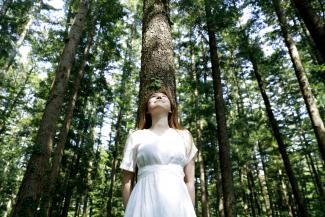
Do the preparation task first. Then read the article and do the exercises.
Preparation
What is Earth Hour?
Every year, in late March, people and institutions come together to switch off all non-essential lights for sixty minutes at 8.30 p.m. local time. They do this to show their support for the fight against the climate crisis and loss of biodiversity. Millions of people all around the world join in, as do governments, businesses and institutions. By switching off their lights and measuring the reduction in the amount of energy that is being used, people are showing that it is possible to make a difference.
But Earth Hour is more than one hour without lights, once a year. It's part of a movement of people who are working together all year round to protect the environment.
How did it start?
The World Wide Fund for Nature in Australia introduced the idea in 2007. They wanted to find a way to raise awareness about climate change. And they wanted to show that when millions of individuals work together, they can make a difference.
The first Earth Hour was held on 31 March 2007 at 7.30 p.m. in Sydney. More than two million residents and 2,000 businesses turned their lights out for one hour. The lights also went out on the famous Sydney Opera House. The people of the city of San Francisco were so inspired by the event in Sydney that they held their own 'Lights Out' event in October of the same year. This was the beginning of the Earth Hour movement.
How many cities take part?
The event has grown over the years, with more and more people, businesses, organisations and governments taking part every year.
In 2008, a year after the first Earth Hour event, 35 countries and more than 400 cities joined in. Websites also took part, turning their homepages black in support of the initiative. By 2012, 152 countries and more than 7,000 cities and towns were taking part. In recent years, the numbers have kept increasing, with more than 188 countries and territories worldwide taking part each year. In 2019, more than two billion photos were shared on social media platforms.
Famous people and famous places
A number of celebrities have put their names to the cause, including singer Ellie Goulding, tennis star Andy Murray, TV host Ellen de Generes, actor Leonardo di Caprio and ex-Beatle Paul McCartney. Politicians and world leaders have also given their support, and thousands of famous landmarks have turned off their lights, including the Eiffel Tower in Paris, the Empire State Building in New York and the Pyramids in Egypt.
What has the movement achieved?
The Earth Hour movement has achieved much more than getting people to turn off their lights. Since 2007, among other actions, they have planted trees in various countries around the world, including a 2,700 hectare forest in Uganda and 17 million trees in Kazakhstan. They worked together to ban the use of plastics on the islands of the Galapagos, one of the most important nature reserves on the planet. And they have sponsored solar power projects in India and the Philippines.
What can I do?
Join the movement. Find out the date and time for this year. Visit the Earth Hour website and find out what's going on. Then get ready to turn off your lights and join the millions of other people around the world who are fighting to save our planet!
Sources:




Do you think Earth Hour is a good idea?
absolutely, this is a great idea many people on the earth participate in it for saving power and light. I will raise awareness for people when we work together we save our earth.
Yes, it's a great idea to raise awareness among people about the conservation of energy and nature. I am from Bangladesh and here we don't participate in earth hour. Though we don't participate in earth hour, we have load-shedding almost every day for 1hour in many cities. It has become pervasive nowadays in my country.
I loved this. I just found out about Earth Hour. I think it's a great idea, but we should do more. The Earth is in a risky situation and we need to take action now. Unfortunately, in my country there is no such thing as the Earth Hour, but it would be pretty nice if there was. Citizens of my country need to be more aware about the situation our Earth is in right now.